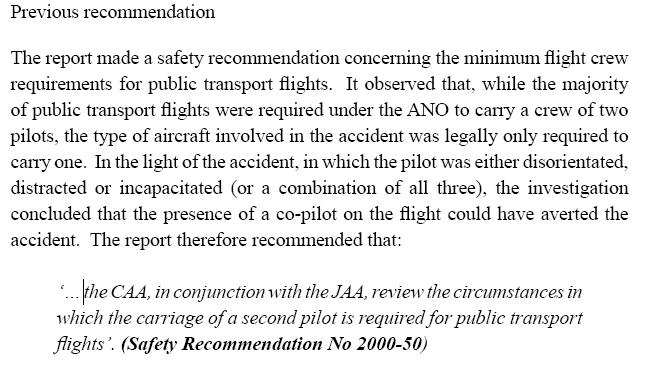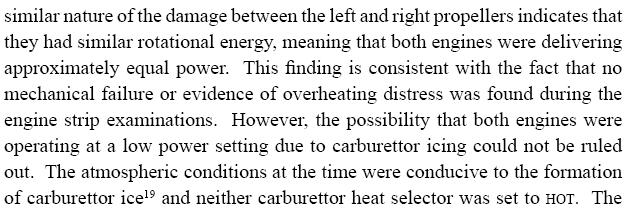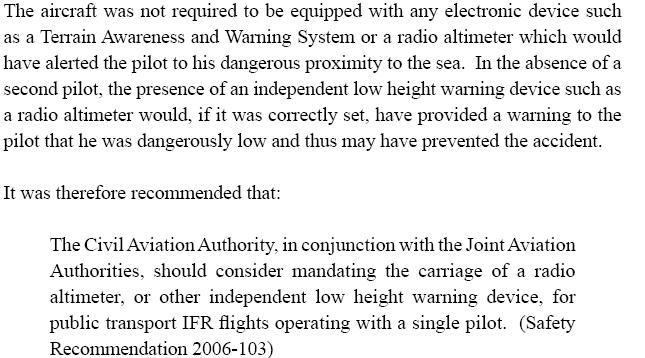|
G-BOMG
(Scottish Air Ambulance Islander Crash off Ayrshire West Coast (WNWest
of Campbelltown) from UK AAIB
link |
 |
Page 43 [51 of 81] It's really all about this. It is
so easy for a single pilot operation to lose the plot at night in
weather. It just takes a moment's distraction or inattention to enter an
unrecoverable and divergent unusual attitude.
The UK CAA accepted the recommendation but then decided not to act
upon it (see page 44 [52 of 81)for their silly reason). |
|
_________________________________________________________________________________ |
____________________ |
 |
The cause of his ditching is also possibly due to
carburettor icing. This claims many pilots who just tend to forget about
it. The conditions certainly demanded it but it wasn't being used.
That type icing can be insidious (the power simply
not being there when you go for it).The possibility of carby ice
affecting both engines equally and simultaneously is very high. |
|

______________________________________________________________________________________________________ |
| The thing to remember is that if the conditions are
conducive to carby ice forming, it WILL form in the carby throat. The
only question is then whether enough will form to choke the gas flow and
affect the engine's power output. In a low power descent Instrument
Approach you're not likely to find out until you go to apply power. The
surprise factor is then going to make carby icing possibly the last
thing that you think of. The other nasty aspect of carby icing is that
by the time you get the symptoms (usually of power loss) it's too late.
Why? because the engine by then isn't capable of generating sufficient
heat fast enough to melt the icing build-up.A
selection of HOT immediately after becoming aware of carby icing can
also lead to a rich cut if the throttle is anyways OPEN (Ice dislodges
and blocks all airflow past the venturi throat).
Although the report canvasses the possibility of carby icing, it's
also given it insufficient analysis (i.e. no mention at all) as a probable cause. |
|
_________________________________________________________________________________ |
____________________ |
 |
Good call, but wouldn't have helped if it was
carby icing stuffing both engines simultaneously |
|
_________________________________________________________________________________ |
____________________ |
| Almost unbelievably
there's nothing whatsoever in the findings or causal factors about the
possibility of carby icing having knocked out any power re-application from
either engine. A double engine failure from carby icing is certainly a
possibility. The engine doesn't really "fail" as such. It keeps running
at low power but fails to produce any power on demand. I've seen that a
number of times
after a protracted descent in
very humid conditions on a
piston-powered machine without fuel injection. The crash
position was around about where the pilot would have been going for
power in the conditions (i.e. he needed a break-out of cloud at around
1000ft to be able to legally circle for r/way 25 - his expressed
intention.). So he needed to level off at 1000ft. That's about when he
would've found the power on demand just wasn't there. At that point he'd
have been checking fuel and even if he had thought of carby icing as a
cause, it
wouldn't have made any difference at that late stage.
james.smith@iinet.net.au |



